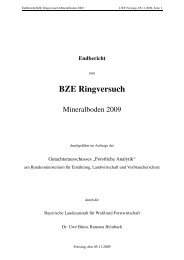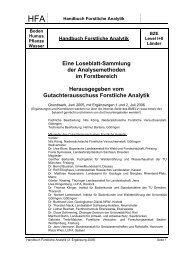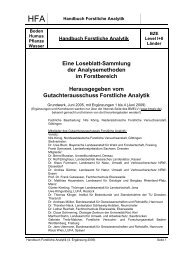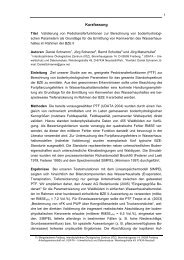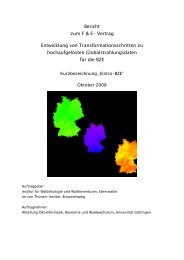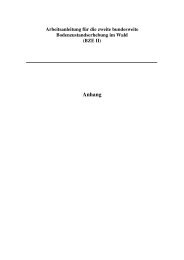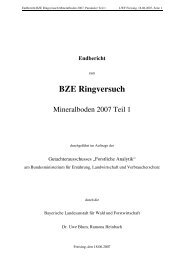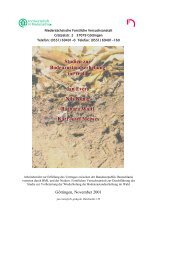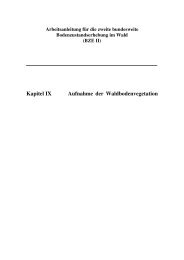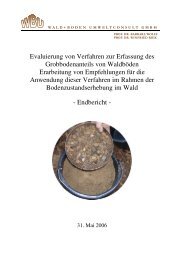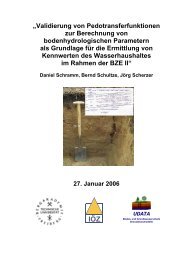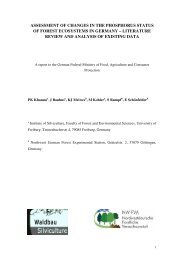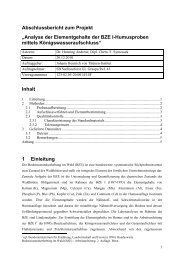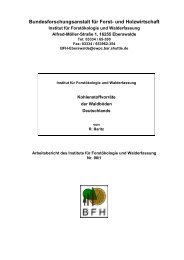assessment of changes in the phosphorus status of forest ...
assessment of changes in the phosphorus status of forest ...
assessment of changes in the phosphorus status of forest ...
Create successful ePaper yourself
Turn your PDF publications into a flip-book with our unique Google optimized e-Paper software.
2.6 Changes <strong>in</strong> P concentrations <strong>in</strong> <strong>the</strong> foliage and leaf litter dur<strong>in</strong>g <strong>the</strong> last<br />
Foliage<br />
10 years at Level II sites <strong>in</strong> Lower Saxony (NS)<br />
It has been previously po<strong>in</strong>ted out that P data obta<strong>in</strong>ed by one time sampl<strong>in</strong>g <strong>of</strong><br />
foliage may not provide useful <strong>in</strong>formation about <strong>the</strong> P <strong>status</strong> <strong>of</strong> a <strong>forest</strong> stand. The<br />
ma<strong>in</strong> reason for that is <strong>the</strong> substantial temporal variation ow<strong>in</strong>g to many factors<br />
outl<strong>in</strong>ed previously <strong>in</strong> <strong>the</strong> review. Thus repeatedly taken samples over a number <strong>of</strong><br />
years provide better <strong>in</strong>formation <strong>of</strong> any change <strong>in</strong> <strong>the</strong> foliar <strong>status</strong>. To assess, whe<strong>the</strong>r<br />
<strong>the</strong>re may be a decl<strong>in</strong>e <strong>in</strong> foliar P nutrition, <strong>the</strong> temporal dynamics <strong>in</strong> P concentrations<br />
<strong>in</strong> <strong>the</strong> current year needles and mature foliage <strong>of</strong> 27 long-term monitor<strong>in</strong>g plots <strong>in</strong><br />
Lower Saxony were assessed statistically. For each site, annual or biannual Pconcentration<br />
values were analysed us<strong>in</strong>g mixed l<strong>in</strong>ear models, which were fitted to<br />
all data for each species for a 10-year period. There were 10 spruce sites, for which<br />
<strong>the</strong> mean P concentrations <strong>of</strong> 1-year old needles and <strong>the</strong> relative proportion <strong>of</strong> 3-year<br />
and 5-year needles are given <strong>in</strong> Table 5. In addition, <strong>the</strong>re were three p<strong>in</strong>e sites, 8<br />
beech sites and 6 oak sites (Fig 7-10). The older spruce needles had lower<br />
concentrations <strong>of</strong> P, 66-82 % <strong>in</strong> 3-yr old and 47–70% <strong>in</strong> 5-yr old needles when<br />
compared to 1-yr old needles. This represents a significant amount <strong>of</strong> P withdrawal,<br />
assum<strong>in</strong>g <strong>the</strong> weights <strong>of</strong> 3- and 5-yr old needles have not <strong>in</strong>creased, which is unlikely.<br />
Table 5: Mean P foliar values <strong>in</strong> <strong>the</strong> current year old (1-yr) needles, and relative<br />
concentrations <strong>in</strong> 3-yr and 5-yr old needles to 1-yr old needles. Mean<br />
values represent 10 years <strong>of</strong> measurements.<br />
Site P <strong>in</strong> 1-yr old Percent <strong>of</strong> P conta<strong>in</strong>ed Percent <strong>of</strong> P conta<strong>in</strong>ed<br />
needles <strong>in</strong> 3-yr old needles <strong>in</strong> 5-yr old needles<br />
mg/g % %<br />
HiKA 1.11 67 59<br />
HiMA 1.18 70 57<br />
HIMJ 1.31 82 70<br />
LBKA 1.33 75 56<br />
LBNH 1.39 77 70<br />
LBSH 1.22 78 70<br />
SLF1 1.38 74 62<br />
SLFD 1.32 70 61<br />
SPFi 1.36 72 55<br />
WIFi 1.47 66 47<br />
37



